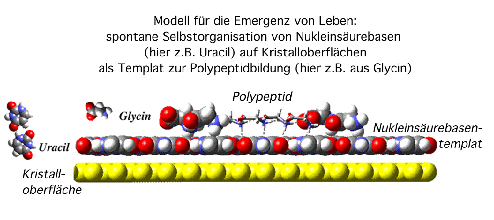
The formation of monolayers of the purine and pyrimidine bases through physisorption mediated molecular self-assembly at the solid-liquid interface, has been proposed to have a functional role in the emergence of terrestrial life (1,2,3). The application of near field microscopy techniques, namely scanning tunneling microscopy (STM), to these supramolecular surface structures has allowed real space analysis with atomic scale lateral resolution. We have suggested that purine and pyrimidine monolayers could be candidates for a stationary phase in organic molecule separation systems, and as templates for the assembly of higher ordered polymers at the prebiotic solid-liquid interface.
We will present the concept of organic monolayer structure determination by combining real space STM technique, low energy electron diffraction and molecular modelling (4, 5) which has been applied to all DNA bases and the RNA base uracil on various inorganic mineral surfaces. In some cases, like for adenine, the spontaneous molecular self assembly from liquid solution leads to localized chiral symmetry break which may have some role in the origin of biomolecular optical asymmetry. The possiblity that purine-pyrimidine arrays assembled on naturally occuring mineral surfaces might act as templates for biomolecular assembly of amino acids is discussed.

References: